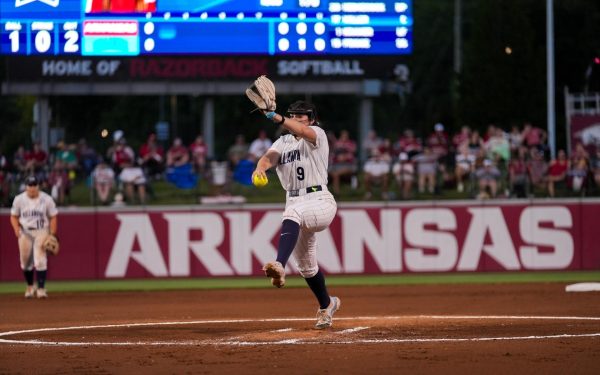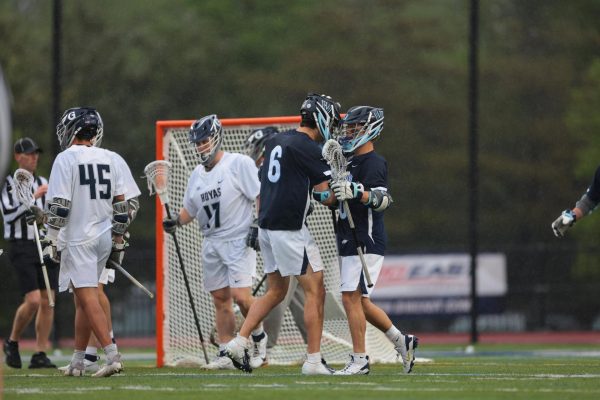The Analytics Behind Baseball’s Tough Season
Courtesy of Villanova Athletics
The Wildcats are currently 11-28 and 5-7 in conference.
April 26, 2023
Villanova’s men’s baseball team has had a season filled with frustration, high highs and lower lows. At 10-28, the wins have been few and far between. Even after a glimmer of optimism from sweeping Butler last weekend, the Wildcats came back a week later this weekend to get swept by Xavier, including a brutal 14-1 loss on Saturday.
The team has been one of the tougher watches on campus. Those who do watch are fatigued, and those who don’t gave up a while ago. But why is the struggle so prevalent?
The answer itself is complicated because baseball itself is complicated. Beyond runs and strikeout is a whole universe of analytics designed to gauge not just the different ways teams are successful – the ways that aren’t as obvious – but why they are that way and how they got there.
Josh Mould is the former president of the Sports Analytics Club at Villanova and will be heading to Boston next year to join the Red Sox as a quantitative analyst. After stepping down as club president, he got involved with the baseball team as its Director of Scouting and Analytics, and has assembled a team of 16 scouts from the club in partnership with the team to help the coaches and players get the best possible sense of how to improve and what needs to be worked on.
“It does not surprise me,” Mould said, when asked about the struggles of the team.
While the team as a whole has struggled, Mould points to the play on the mound, putting the bats in a position to have to perform exceptionally well in order to have any chance of a competition.
“I think [the struggles are] most prevalent on the pitching side of things, where even in the games where we win, the other team scored a lot,” he said. “I think in our last four wins, the other team has scored five runs three of those times. So we’ve needed offense to compensate for that.”
But it’s not just throwing the ball, it’s where it’s being placed. “Command” is a term in baseball to measure how effectively a pitcher can place the ball in and out of the strike zone with attention based on their strategy. Analysts will determine what the ideal pitch placement is based on other factors, and then quantify a rating for that pitcher’s command.
“To put it simply, we have struck out 292 batters and walked 218,” Mould said. “So that’s not a very good strike-rate-to-walk rate ratio. Usually you want that to be around three [to one]. That’s a clear area that the team is struggling with, walking a lot of batters. It’s true that you don’t always want to throw strikes because you want batters to chase, but we just haven’t been able to locate in great spots. But the stuff is there. I’d say it’s about average when you look widespread around college baseball. But we do have some pitchers with good metrics there.”
The Wildcats are getting on base at a rate of .347 with a walk rate BB% (walk rate) of 12.2%, while they’re letting their opponents get on base at a rate of .419 and a BB% of 14.6%. Those gaps are not good.
“Stuff” refers to the movement the ball has when pitching a certain type of pitch, for example, a curveball with not much verse has poor stuff.
The walks that are being generated from the pitching staff are coming from pitchers trying to get batters to bite on balls outside the zone, but they don’t. The percentage of time a pitcher gets a player to swing and miss on a pitch outside the strike zone is called “Whiff Rate,” and the Wildcat’s are low in that category. Of the 397 teams with at least 100 pitches logged on trackman devices in college baseball, Villanova projected Whiff probability is 315th. But Mould thinks there’s potential.
“If you look at all the teams on trackman this year, they have very low whiff probabilities,” he said. “But they’re not far from success. If they were to improve on location like I said earlier, their whiff rates would skyrocket.”
Outside of walks, the pitchers are having their pitches get hit pretty hard by their opponent’s lineups, causing matchups that often seem uncompetitive. This has caused a pattern of Villanova getting down by multiple runs early on so that even if they make adjustments, the hole is too deep to dig out of.
There are two metrics that can be used to quantify why this happens. One is wOBA, or Weighted On Base Average, which is a form of base percentage that’s weighted by run values of each event – singles and walks are weighed less than doubles and triples. The other is FIP, or Field Independent Pitching, which is ERA that only accounts for pitching that causes strikes, walks, and homerun. The Wildcats have a poor FIP of 5.43, requiring exceptional hitting from the offense for the game to be competitive.
“The pitchers are getting hit pretty hard in terms of the metric there,” Mould said. “The wOBA against is very high, I think the lowest picture we have in terms of that with at least five innings pitched is 0.38. So it’s very high. A lot of walks are mainly the cause of that, so FIP is very high right now. Some of that could just be hitting some bad luck.”
But in a lot of ways, the offense is there, and it’s coming from slugging to hit the ball for multiple bases at a time. Villanova has scored double digit runs in its last four wins and in five of its ten total wins this season. Villanova strikes out more than its opponents (22.6% to 19.9%), but the power on the bat is there.
“I think it’s coming a lot from slugging,” Mould said. “Cam Hassert [has] been a big breakout player I would say. He wasn’t expected to do as well as he’s doing, but he’s been really impressive. His OPS is 1.025. His wOBA is 4.68. Our swing decisions metrics are showing we have some ups and downs with it. I would say more of our players are below average than above average. But we have a mix. But players are definitely seeming to make up for it with hitting the ball hard, and that has shown to pay off.”
The gap between living up to success and falling short of it in baseball can come down to the smallest of adjustments. The baseball team is more than just a win-loss record: they’re a group of people with skills, ones that can be refined and harnessed into runs that lead to wins.













